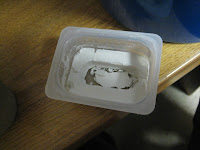



This is the blog for the Philadelphia University Industrial Design Fabrication class. The class focuses on mock-up and prototyping techniques used in Industrial design. Comments are welcome, we would love to hear what you think.














 the second experiment i did was try to make a very small mold out of plaster and yellow foam to pour cement later on into the plaster mold. to prevent the yellow foam piece to stick to the plaster i covered the piece with oil but as the plaster dried and i tried to get the yellow foam out the mold broke so i decided to make a mold out of styrene in the vacume form
the second experiment i did was try to make a very small mold out of plaster and yellow foam to pour cement later on into the plaster mold. to prevent the yellow foam piece to stick to the plaster i covered the piece with oil but as the plaster dried and i tried to get the yellow foam out the mold broke so i decided to make a mold out of styrene in the vacume form



 one of my experiments was to try and play with the color of the cement so i pour clear oil in one cup and colored oil in the other so i put the concrete in each cup and let it dry over night but when the cement was dry the pigment in the cement changed very little not even enough to notice it at all so i am going to try to dye the cement with cement dye
one of my experiments was to try and play with the color of the cement so i pour clear oil in one cup and colored oil in the other so i put the concrete in each cup and let it dry over night but when the cement was dry the pigment in the cement changed very little not even enough to notice it at all so i am going to try to dye the cement with cement dye








